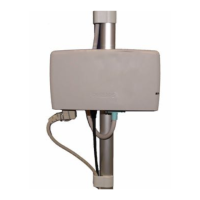93
7
7ECG, Arrhythmia, ST and QT
Monitoring
The electrocardiogram (ECG) measures the electrical activity of the heart and displays it on the
monitor as a waveform and a numeric. This section also tells you about arrhythmia monitoring (see
page 109), ST monitoring (see page 121) and QT monitoring (see page 131).
Skin Preparation for Electrode Placement
Good electrode-to-skin contact is important for a good ECG signal, as the skin is a poor conductor of
electricity.
1 Select sites with intact skin, without impairment of any kind.
2 Clip or shave hair from sites as necessary.
3 Wash sites thoroughly with soap and water, leaving no soap residue.
We do not recommend using ether or pure alcohol, because this dries the skin and increases the
resistance.
4 Dry skin thoroughly.
5 Gently abrade the skin using ECG skin preparation paper to remove dead skin cells to improve the
conductivity of the electrode site.
Connecting ECG Cables
1 Attach the clips or snaps to the electrodes before placing them. If you are not using pre-gelled
electrodes, apply electrode gel to the electrodes before placement.
2 Place the electrodes on the patient according to the lead placement you have chosen.

